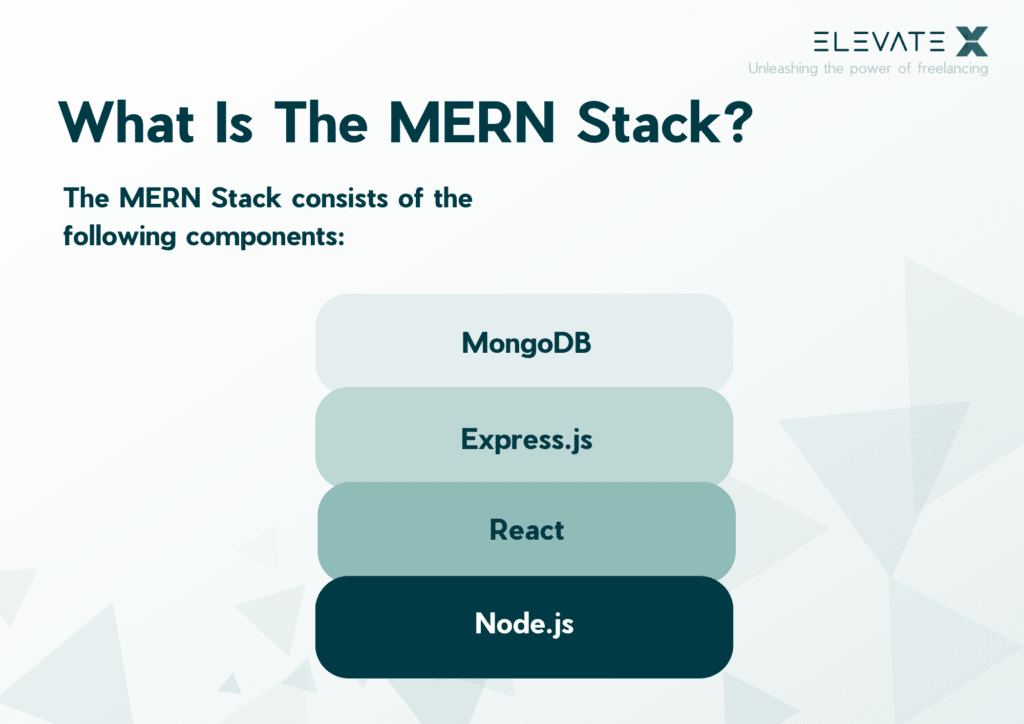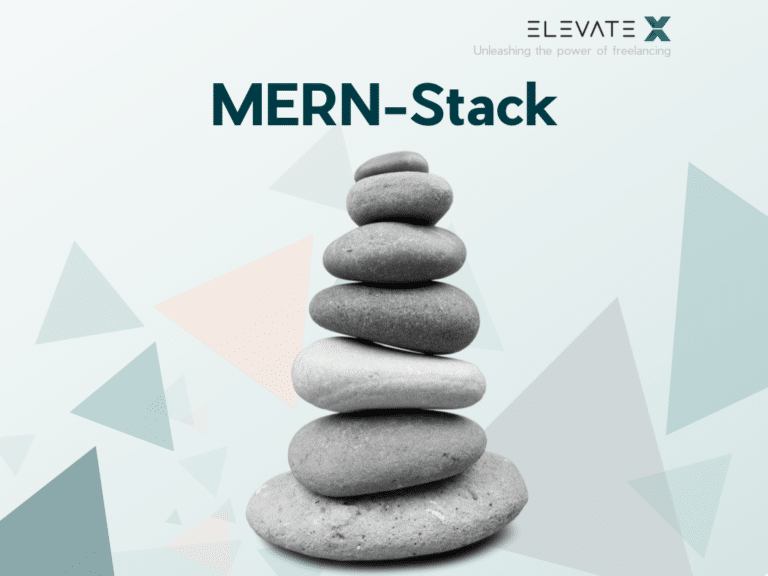The MERN Stack is considered an excellent solution for web application development. Freelancers who can work competently with it are called Full-Stack developers and are in demand in many places. But what lies behind it? How does the MERN Stack work, and what benefits does it offer? These are some of the central questions surrounding this topic that we will answer for you below.
What Is A Stack In Software Development?
A stack is a combination of independent components that collectively enable the development and execution of applications. Sometimes a distinction is made between software stacks and technology stacks. This differentiation is intended to show that only programs or hardware may be included in the stack. However, this separation is not entirely clean, as some software interacts with hardware. Applications also always require some hardware, such as storage space or network connections.
Stacks are typically arranged hierarchically. At the bottom is usually the platform component, such as the part of the stack that can communicate with the operating system. Commonly, web server components, databases, and runtime environments follow. The exact structure of the stack depends on its specific purpose.
KEY POINTS
- The MERN Stack is a Full-Stack solution.
- It is used for the development and execution of web applications and Single-Page Applications (SPAs).
- It consists of the components MongoDB, Express.js, React, and Node.js.
- It supports the development of both the client and server parts of an application using JavaScript.
What Is The MERN Stack?
MERN is an acronym for the components of the stack. The MERN Stack consists of the following components:
- MongoDB: The NoSQL database allows document indexing and enables you to store information in the form of flexible and scalable JSON documents.
- Express.js: This component is the web application framework for Node.js. It provides a simple API structure and middleware for processing requests and responses.
- React: The JavaScript library is used to build user interfaces, allowing you to develop interactive user interfaces quickly and efficiently.
- Node.js: It is a cross-platform open-source runtime environment for JavaScript. You can write server-side code with its help. It is a scalable platform, making it excellent for web application development.

How Does The MERN Stack Work?
In essence, the MERN Stack works as follows: Node.js and Express.js provide the server components, while MongoDB serves as the database, and React serves as the front-end library. Information is passed between MongoDB and Express.js, and users interact with the app through the user interface created using React.
Is The MERN Stack A Full-Stack Solution?
The MERN Stack is a full-stack solution for web application development. The term “Full-Stack” means that the stack covers all the necessary technologies and components to develop both the server and client parts of a web application. It also enables state management, and tools like the Redux Toolkit can be used for this purpose.
When To Use The MERN Stack For Your Project
In web development, MERN Stacks are generally a good choice. The stack is particularly suitable when you plan to use automation tools that run in an app or on a website, often used for marketing purposes. It is also recommended for projects where security is crucial, as the stack has a reputation for producing reliable applications. Especially in the finance sector, it has become increasingly popular.
As a note: The MERN Stack is designed for fast and efficient development. This is ideal for smaller and medium-sized projects. For larger endeavors, it may make sense to explore other technologies, but this decision should be made based on the specific situation.
At A Glance: Advantages Of The MERN Stack For The Back-End
- RESTful APIs: The MERN Stack allows for the creation of RESTful (Representational State Transfer) APIs, providing a standardized interface for communication between the front-end and back-end.
- Increased Speed with JavaScript: The MERN Stack enables fast web application development, as developers can write server-side and client-side code in a single language – JavaScript.
- High Performance: Node.js is excellent for handling many concurrent connections, which positively impacts the responsiveness of back-end systems.
At a Glance: Benefits of Using the MERN Stack for the Front-End
- UI components developed with React are reusable, making long-term work more manageable. Note that this advantage applies to the entire codebase since the entire application is written in JavaScript and can be reused.
- Components can be organized hierarchically to optimize the user experience. A Virtual DOM also facilitates easier updates to individual components.
- In addition to user interactions, React in the front-end can create components for displaying data or managing the application.
Overall Special Advantage: Community Support
The MERN Stack technologies have active and continuously growing communities. This means that as a developer, you have access to a wealth of resources, documentation, tutorials, and solutions, which is highly valuable for both learning the technologies and resolving issues.
Are you looking for a Full-Stack Developer?
What Is the Difference Between The MEAN Stack And The MERN Stack?
The MEAN Stack and the MERN Stack are both full-stack web development technologies composed of similar components. The main difference between the two stacks is that the MEAN Stack uses Angular as the front-end framework, while the MERN Stack uses React as the front-end library. The other components are identical. Angular is a comprehensive framework offering many features for web application development but is more complex than React and has a steeper learning curve.
The choice between MERN and MEAN depends on the preferences and requirements of the developer or team, as both technology stacks provide robust solutions for web application development but with a slightly different focus: where complexity is required, the MEAN Stack is preferred over the MERN Stack.
Conclusion: The MERN Stack Can Provide Significant Value To IT Freelancers
In the world of web development, efficiency and flexibility are crucial, especially for IT freelancers. The MERN Stack has proven to be an extremely valuable resource when seeking a powerful full-stack solution. With React as the front-end library, freelancers can create appealing user interfaces and offer a responsive user experience thanks to the Virtual DOM. Express.js and Node.js on the server-side enable efficient back-end development and the freedom to write server-side logic in JavaScript. Using MongoDB as a NoSQL database allows flexible and scalable data management.
The integration of all these components into the MERN Stack creates a consistent development ecosystem, providing developers with a rich selection of open-source resources and tools. This accelerates development and allows freelancers to focus their time and energy on the essential task: creating great applications.
However, the MERN Stack is more than just a collection of technologies. It is a way to develop contemporary web applications that meet today’s requirements. With its ability for rapid development, scalability, and easy maintenance, the MERN Stack is an invaluable tool. Your work, however, is what makes it truly special.
Working with the MERN Stack is highly sought after because it provides a fast and efficient platform for web application development. The MERN Stack has gained popularity in recent years and has become one of the most commonly used full-stack web development technologies.
The MERN Stack is not necessarily harder to learn than other technology stacks, but it does require time, dedication, and practice, especially if you have no prior experience in web development. With the right approach and appropriate learning resources, you can certainly learn the MERN Stack and be able to effectively develop web applications. We offer a variety of valuable resources, such as an explanation of “Frontend vs. Backend vs. Full-Stack.”
The MERN Stack typically does not use the “MVC” (Model-View-Controller) concept in the “traditional” sense. However, developers can still implement an MVC pattern in their MERN application, even though the individual technologies are different tools. This works as follows:
- Model: This is the MongoDB database, as it deals with data representation.
- View: This is the part of the application that is visible and is generated using React.
- Controller: This is the application’s control, achieved through Express.js on the server side.
Overall, these are primarily semantic differences.








